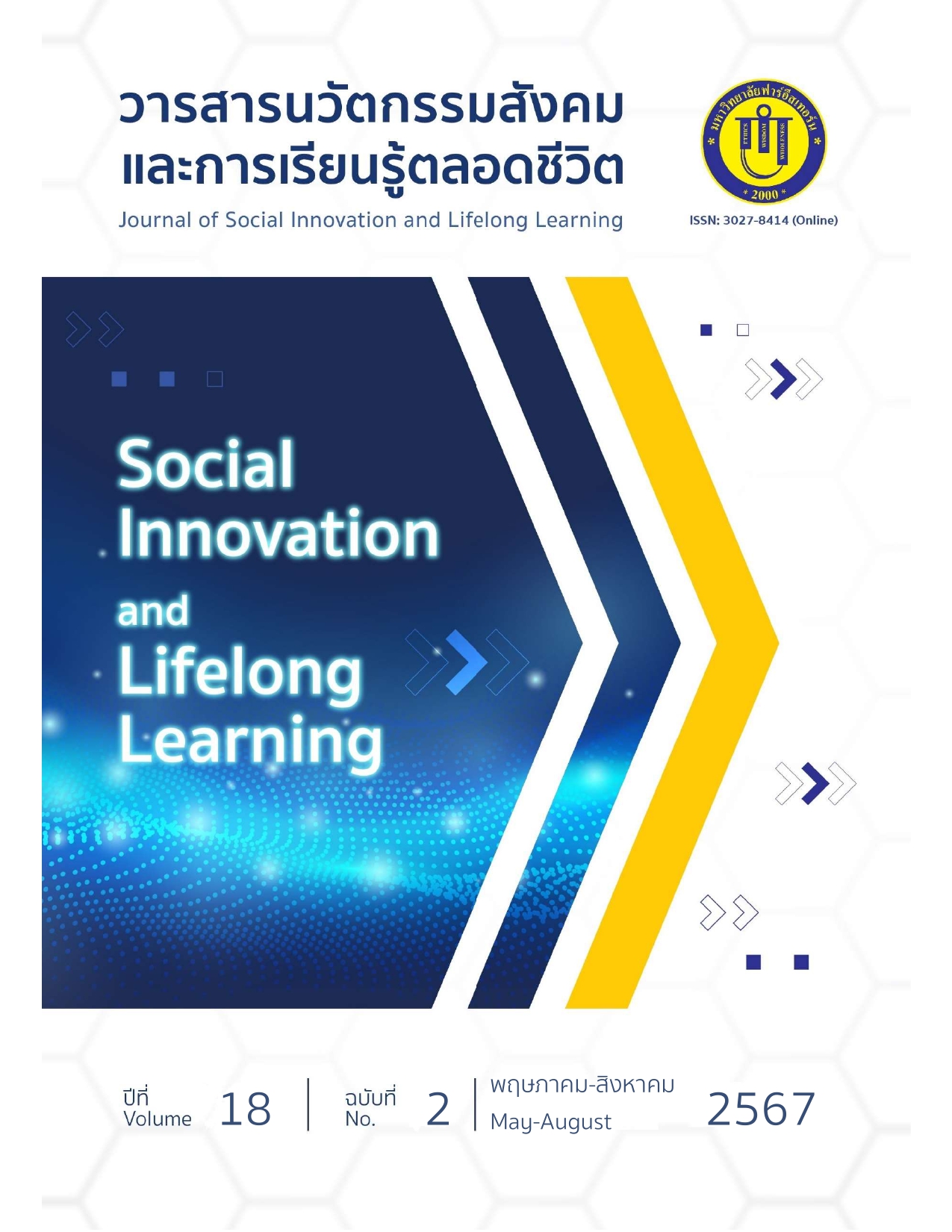Princess Consort Dara Rasmi in the Role of Driving Societal Change in the Cultural Heritage Management Dimension
Main Article Content
Abstract
Cultural capital is considered a valuable heritage that requires a strong foundation for its management to ensure its preservation amidst the tides of change. Chom Thong District in Chiang Mai Province is an area rich in natural beauty, art, traditions, and a diverse culture that has been well-known both domestically and internationally for generations. This academic article aims to study the cultural capital derived from the royal duties of Princess Dara Rasmi, specifically in the context of managing cultural heritage in Chom Thong District. Despite being a remote area, she played a significant role there. As a visionary leader, she contributed to the preservation of religion, established cultural norms, and passed down traditions, lifestyles, and ways of living from generation to generation, as evident in Chom Thong District today. This has led to the development of a unique identity in the area, reflecting its status as a land of faith. Future generations can use this cultural heritage to drive society in the context of managing cultural capital, supporting the development of the creative economy in the new normal era. Furthermore, she serves as a model for scholars and the public, instilling a sense of awareness and pride in preserving and passing on Lanna cultural capital, creating a knowledge base and wisdom that will widely disseminate cultural capital and pass on this cultural beauty as a world heritage for generations to come.
Article Details

This work is licensed under a Creative Commons Attribution-NonCommercial-NoDerivatives 4.0 International License.
1. Any views and comments in the Journal of Social Innovation and Lifelong Learning are the authors’ views. The editorial staff have not to agree with those views and it is not considered as the editorial’s responsibility.
2. The responsibility of content and draft check of each article belongs to each author. In case, there is any lawsuit about copyright infringement. It is considered as the authors’ sole responsibility.
3. The article copyright belonging to the authors and The Far Eastern University are copyrighted legally. Republication must be received direct permission from the authors and The Far Eastern University in written form.
References
คมสันต์ คำวงค์. (2566). พิพิธภัณฑ์พระตำหนักดาราภิรมย์เชิญเที่ยวชมงานวันพระราชชายา เจ้าดารารัศมี ประจำปี 2566. สถานีวิทยุกระจายเสียงแห่งประเทศไทย จังหวัดเชียงใหม่. https://radiochiangmai.prd.go.th/th/content/category/detail/id/57/iid/238331
จำรัส กลิ่นหนู. (2564). การจัดการทุนทางวัฒนธรรมเพื่อยกระดับเศรษฐกิจฐานราก ย่านสร้างสรรค์ เมืองเก่าเชียงราย (รายงานผลการวิจัย). กรุงเทพฯ: หน่วยบริหารและจัดการทุนด้านการพัฒนาระดับพื้นที่ (บพท.).
จิรชาติ สันต๊ะยศ. (2553). การสร้าง “พระราชชายา เจ้าดารารัศมี” ให้เป็นบุคคลสําคัญในประวัติศาสตร์ทศวรรษ 2500 - ปัจจุบัน. วารสารมหาวิทยาลัยศิลปากรฉบับภาษาไทย, 30(1), 25 – 39. https://so05.tci-thaijo.org/index.php/sujthai/article/view/7083
จุฬาลงกรณ์มหาวิทยาลัย. (2562). ดารารัศมี สายใยรักสองแผ่นดิน (พิมพ์ครั้งที่ 4). กรุงเทพฯ: สำนักพิมพ์แห่งจุฬาลงกรณ์มหาวิทยาลัย.
ช่อพฤกษ์ ผิวกู่. (2560). แนวทางการพัฒนาทุนวัฒนธรรมนวัตกรรมสู่ Thailand 4.0. รายงานสืบเนื่องการประชุมวิชาการระดับชาติ สถาบันวิจัยและพัฒนา มหาวิทยาลัยราชภัฏกำแพงเพชร ครั้งที่ 4 (น.134-142). กำแพงเพชร: มหาวิทยาลัยราชภัฏกำแพงเพชร.
โชคอนันต์ วาณิชย์เลิศธนาสาร. (2564). การจัดการทุนทางวัฒนธรรมพื้นที่เมืองแพร่ เพื่อเพิ่มศักยภาพด้านการแข่งขันของผู้ประกอบการวิสาหกิจทางวัฒนธรรม (รายงานผลการวิจัย). กรุงเทพฯ: หน่วยบริหารและจัดการทุนด้านการพัฒนาระดับพื้นที่ (บพท.).
ดวงฤทธิ์ เบ็ญจาธิกุล ชัยรุ่งเรือง. (2566). การขับเคลื่อน Soft Power: อัตลักษณ์ท้องถิ่นภาคใต้เพื่อส่งเสริมการท่องเที่ยวจังหวัดชุมพร. วารสารสันติศึกษาปริทรรศน์ มจร, 11(5), 1922 – 1935. https://so03.tci-thaijo.org/index.php/journal-peace/article/view/269605
นพพร บุุญแก้ว, ประสพ เรียงเงิน, พิสุทธิ์ ทรัพย์วิจิตร, และ วรญาณ บุญณราช. (2565). บทบาทของวัฒนธรรมกับการส่งเสริมเศรษฐกิจสร้างสรรค์ของประเทศไทย. วารสารรัฏฐาภิรักษ์, 63(3), 108 -121. https://so05.tci-thaijo.org/index.php/ratthapirak/article/view/257248
ผู้จัดการออนไลน์. (2563). กรมศิลป์พบ 7 แหล่งโบราณคดี ศิลปะสุโขทัย. https://mgronline.com/qol/detail/9630000026487
พงศ์กร จันทราช, ประพันธ์ อภิวงค์, จำเริญ เขื่อนแก้ว, สุพัฒนวรี ทิพย์เจริญ, นิภาพรรณ ทรายแก้ว, สืบพงษ์ พงษ์สวัสดิ์, จุฑามาศ จินตนา, สุชาดา พันธุ์สถิตย์วงศ์ และ นล นาคนาคา. (2567). การพัฒนานวัตกรรมชุมชนสำหรับจัดการทุนทางวัฒนธรรม อำเภอจอมทอง จังหวัดเชียงใหม่ เพื่อยกระดับเศรษฐกิจฐานราก และสำนึกท้องถิ่นในยุคสังคมวิถีใหม่ (รายงานผลการวิจัย). กรุงเทพฯ: กองทุนส่งเสริมวิทยาศาสตร์ วิจัย และนวัตกรรม (ววน.) และหน่วยบริหารและจัดการทุนด้านการพัฒนาระดับพื้นที่ (บพท.).
พิพิธภัณฑ์ผ้า แสงดา บันสิทธิ์. (2566). พิพิธภัณฑ์ผ้า แสงดา บันสิทธิ์. มูลนิธิแสงดา บันสิทธิ์ บ้านไร่ไผ่งาม. https://www.facebook.com/Baanraipaingarm/?locale=th_TH
พิพิธภัณฑ์พระตำหนักดาราภิรมย์. (2567). โครงการส่งเสริม สนับสนุนศิลปะการแสดงพื้นบ้าน “ต้นกล้าดาราภิรมย์ รุ่นที่ 1”. https://www.facebook.com/DaraphiromPalace
พระครูใบฎีกาธีรยุทธ ภู่โคกหวาย และ พระเทพศาสนาภิบาล. (2565). รูปแบบกลไกการขับเคลื่อนเศรษฐกิจและสังคมในการพัฒนาศักยภาพทุนทางทรัพยากรและทุนทางวัฒนธรรมไทย. วารสาร มจร พุทธปัญญาปริทรรศน์, 7(1), 254-269. https://so03.tci- thaijo.org/index.php/jmbr/article/view/257668
โรม บุนนาค. (2559). เจ้าหญิงล้านนา “พระราชชายา เจ้าดารารัศมี” ผู้เป็นที่เสน่หาแห่ง “พระปิยะมหาราช”!!!. เรื่องเก่าเล่าสนุก ผู้จัดการออนไลน์.
https://mgronline.com/onlinesection/detail/9590000016928
ภักดีกุล รัตนา. (2563). การศึกษา “คุณลักษณะ” ของผู้หญิงล้านนาตามแนวคิดคุณลักษณศึกษา. วารสารสวนสุนันทาวิชาการและวิจัย, 14(2), 1-15. https://so05.tci- thaijo.org/index.php/ssajournal/article/view/251456
ภักดีกุล รัตนา และ ไพโรจน์ ไชยเมืองชื่น. (2564). บทบาทการสร้างสรรค์และการสืบทอดมรดกภูมิปัญญาทาง
วัฒนธรรมล้านนาของพระราชชายา เจ้าดารารัศมี. วารสารไทยศึกษา, 17(2), 51-72. https://so04.tci-thaijo.org/index.php/TSDJ/article/view/264255
มูลนิธินวราชดำรินุรักษ์ฝ่ายเหนือ. (2566). ภูษาล้านนาดารารัศมี. https://www.facebook.com/profile.php?id=100064572973937
มูลนิธินวราชดำรินุรักษ์ฝ่ายเหนือ โดย เจ้าวงศ์สักก์ ณ เชียงใหม่. (ม.ป.ป.). กู่เจ้าหลวงเชียงใหม่ พุทธศักราช ๒๕๔๔ ในพุทธศตวรรษที่ ๒๔ จนถึงปัจจุบัน ณ วัดสวนดอก. Do my best ltd.
ศูนย์มรดกเมืองเทศบาลนครเชียงใหม่. (2562). ลำไยต้นกล้าจากน้ำพระทัยสู่ผลไม้เศรษฐกิจเมืองเหนือ. https://www.facebook.com/photo/?fbid=2416478951753409&set=pcb.2416482085086429&locale=th_TH
สยามรัฐออนไลน์. (2564). นำทุนวัฒนธรรมต่อยอดเศรษฐกิจสร้างสรรค์ เพื่อการพัฒนายั่งยืน. https://siamrath.co.th/n/226751
สำนักงานเกษตรอำเภอจอมทอง. (2566). พืชที่มีศักยภาพ(สินค้าเด่น)จอมทอง. https://chiangmai.doae.go.th/chomthong/?p=310
สำนักโฆษก สำนักเลขาธิการนายกรัฐมนตรี ทำเนียบรัฐบาล. (2560). Thailand 4.0 ขับเคลื่อนอนาคตสู่ความมั่นคง มั่งคั่ง ยั่งยืน. วารสารไทยคู่ฟ้า, 33, 1–44. https://spm.thaigov.go.th/FILEROOM/spm-thaigov/DRAWER004/GENERAL/DATA0000/00000368.PDF
สำนักบริหารศิลปวัฒนธรรมจุฬาลงกรณ์มหาวิทยาลัย. (2566). กุหลาบจุฬาลงกรณ์. https://www.cuartculture.chula.ac.th/news/10589/
สุบรรณ เอี่ยมวิจารณ์. (2565). นวัตกรรมทางเทคโนโลยี: แนวคิดเพื่อการขับเคลื่อนเศรษฐกิจในยุคเศรษฐกิจแพลตฟอร์ม. วารสารสถาบันวิจัยและพัฒนา มหาวิทยาลัยราชภัฏมหาสารคาม, 9(1), 1-24. https://so03.tci-thaijo.org/index.php/rdirmu/article/view/252941
อำเภอจอมทอง จังหวัดเชียงใหม่. (2556). พระอัฐิเจดีย์ (กู่) พระเจ้าอินทวิชยานนท์ บนยอดดอยอินทนนท์. https://www.facebook.com/CHOMTHONGCHIANGMAI/photos/a.138268952897362/544304815627105/?type=3
Cultural Map Thailand. (2024). Wat Prathat Sri Chomthong Worwihan. https://culturalmapthailand.info/map
OneChomThong. (2567). บ้านผ้าทอจอมทอง. https://www.facebook.com/OneChomThong/
Unesco. (2023). World Heritage. https://www.unesco.org/en/world-heritage
World Heritage Convention. (2024). World Heritage Convention. https://whc.unesco.org/en/about/

